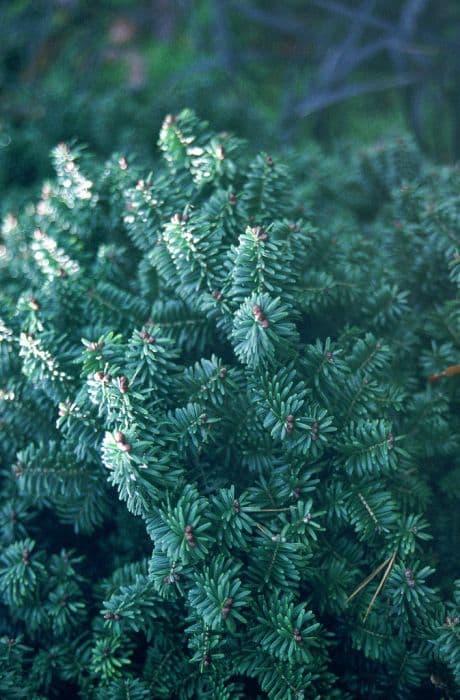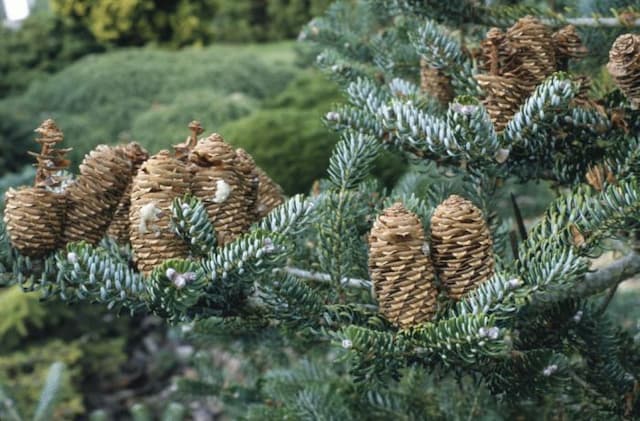Corsican Pine Pinus nigra subsp. laricio

ABOUT
The plant known as the Corsican pine is an evergreen conifer with a dark and dense canopy. It has a distinctive appearance, characterized by its long, stiff needles that are grouped in pairs. These needles exude a lush, deep green color, providing a rich visual texture. As the seasons change, this plant retains its color, keeping landscapes vibrant year-round. The bark of the Corsican pine is another defining feature. It presents with a rugged and furrowed texture, ranging in color from gray to blackish tones. Over time, the bark may acquire deep fissures, adding to the tree's overall stately and enduring appearance. Focusing on the reproductive aspects, the Corsican pine produces cones that have a woody and robust structure. These cones can vary in color, often presenting shades from light brown to a more chestnut coloration as they mature. The shape of the cones is generally conical, and though size is not discussed, their proportions are substantial enough to be noticeable on the branches. Overall, the Corsican pine's foliage, bark, and cones contribute to its striking appearance, making it both a practical and ornamental choice for various landscapes where size considerations are a non-issue. It provides texture, color, and an evergreen presence throughout the seasons.
About this plant
 Names
NamesFamily
Pinaceae.
Synonyms
Corsican Pine, Black Pine, Calabrian Pine, Laricio Pine.
Common names
Pinus laricio, Pinus nigra var. corsicana, Pinus nigra var. calabrica, Pinus nigra var. laricio, Pinus nigra var. maritima, Pinus nigra var. poiretiana.
 Toxicity
ToxicityTo humans
The most common common name for Pinus nigra subsp. laricio is Corsican pine. Generally, Corsican pine is not considered to be toxic to humans. There are no significant toxins present in this plant that would cause serious harm if ingested. However, it is important to note that consuming non-food plants can be risky, as individual allergies or sensitivities might cause adverse reactions. If ingested, plant parts such as needles may cause physical discomfort or gastrointestinal irritation. It is always advised to exercise caution and prevent intentional or accidental ingestion of plant parts not intended for human consumption.
To pets
The most common common name for Pinus nigra subsp. laricio is Corsican pine. Corsican pine is generally not considered toxic to pets. There is no well-documented evidence of serious poisoning in pets such as cats and dogs from ingesting parts of this plant. However, the ingestion of pine needles can lead to gastrointestinal upset, such as vomiting or diarrhea, due to the physical irritation they cause in the digestive tract. It is a good practice to prevent pets from chewing on or ingesting parts of any plants not meant for animal consumption to avoid any potential discomfort or health issues.
 Characteristics
CharacteristicsLife cycle
Perennials
Foliage type
Evergreen
Color of leaves
Green
Height
60 feet (18 meters)
Spread
20 feet (6 meters)
Plant type
Tree
Hardiness zones
6
Native area
Mediterranean
Benefits
 General Benefits
General Benefits- Erosion Control: Its extensive root system stabilizes soil and prevents erosion, particularly on slopes and in areas susceptible to degradation.
- Carbon Sequestration: As a conifer, the Corsican pine effectively captures carbon dioxide, contributing to the reduction of greenhouse gases in the atmosphere.
- Habitat Creation: It provides habitat for wildlife, offering shelter and nesting sites for various birds and other animals.
- Reforestation: Used in reforestation projects due to its robustness and adaptability, it helps in restoring degraded landscapes.
- Shade and Shelter: The tree's dense foliage offers shade and wind protection for understory plants, animals, and human habitation.
- Wood Production: It yields valuable timber that is used in construction, furniture, and paper industries.
- Landscape Aesthetics: With its majestic appearance, it is planted for ornamental purposes in parks and large gardens.
- Recreational Use: Forests of the Corsican pine are often used for outdoor activities like hiking, bird-watching, and nature education.
 Medical Properties
Medical Properties- Antiseptic: Corsican pine has been traditionally used for its antiseptic properties, which may be beneficial in preventing infection in wounds.
- Respiratory Health: The essential oil extracted from Corsican pine is sometimes used in aromatherapy for respiratory conditions, as it is believed to help clear the sinuses and relieve congestion.
- Anti-inflammatory: Compounds present in Corsican pine may possess anti-inflammatory properties, potentially helping to reduce inflammation and related pain.
- Antioxidant: Corsican pine may have antioxidant effects, which could help in protecting the body from oxidative damage linked to various diseases.
 Air-purifying Qualities
Air-purifying QualitiesThis plant is not specifically known for air purifying qualities.
 Other Uses
Other Uses- The wood of Corsican pine is often used in carpentry for creating sturdy furniture due to its durability and appealing grain.
- Corsican pine's resin can be tapped and processed to make turpentine, which is used as a solvent in the paint industry.
- The tree can be cultivated for ornamental purposes in parks and large gardens for its aesthetic appeal.
- The bark of Corsican pine can be used in tanning leather, providing the tannins necessary for the process.
- The needles of the tree are sometimes used in crafts for creating pine-needle baskets and other woven items.
- In landscaping, this species is used in windbreaks and noise barrier plantings due to its dense foliage.
- Due to its height and dense branches, Corsican pine is used as a privacy screen in residential and commercial properties.
- The needles, when fallen, can be gathered and used as a natural mulch for gardening, providing nutrients to the soil as they decompose.
- The cones can be collected and used as biomass fuel or as decorative elements for crafts and festive decorations.
- Wood shavings and sawdust from Corsican pine are often utilized in the manufacture of particleboard or fiberboard, offering a sustainable material option for construction.
Interesting Facts
 Feng Shui
Feng ShuiThe Corsican Pine is not used in Feng Shui practice.
 Zodiac Sign Compitability
Zodiac Sign CompitabilityThe Corsican Pine is not used in astrology practice.
 Plant Symbolism
Plant Symbolism- Resilience: As a species of the pine family, the Corsican pine (Pinus nigra subsp. laricio) symbolizes resilience because of its ability to thrive in various climates and withstand harsh conditions.
- Longevity: Corsican pines can live for centuries, making them emblematic of longevity and endurance through time.
- Steadfastness: The sturdy and unwavering nature of Corsican pines represents steadfastness and reliability.
- Peace: In many cultures, pine trees are considered symbols of peace and are often used to represent tranquility and calmness.
- Wisdom: The ancient and evergreen aspects of the Corsican pine are associated with wisdom and insight that stands the test of time.
 Water
WaterCorsican pine (Pinus nigra subsp. laricio) prefers to be watered deeply and infrequently to promote strong root growth. Typically, watering young trees with about 5 gallons per week during dry periods without rainfall is sufficient. For established trees, natural rainfall should be enough, and supplemental watering can be reduced or eliminated unless there is a severe drought. It is important to avoid overwatering, as this can lead to root rot. The soil should be allowed to dry out between watering sessions.
 Light
LightCorsican pine thrives in full sun exposure, meaning it prefers at least 6 hours of direct sunlight daily. This tree should be planted in a location where it can receive unfiltered sunlight throughout the day, as this is crucial for its health and vigor. It's well-suited for open landscapes or large yards where it won't be overshadowed by other taller structures or trees.
 Temperature
TemperatureCorsican pine is adapted to a wide range of temperatures, but it grows best in areas where the temperature typically stays between 20°F and 80°F. It can survive minimum temperatures down to -20°F and maximum temperatures well above 100°F. The ideal temperature for this tree is the moderate climate typical of its natural habitat in the Mediterranean region.
 Pruning
PruningCorsican pine typically requires minimal pruning, mainly to remove dead or damaged branches to maintain plant health. The best time to prune is late winter or early spring before new growth begins. If shaping is necessary for landscaping purposes, it is best to do so sparingly and ensure that no more than one-third of the branches are removed in a single year.
 Cleaning
CleaningNot needed
 Soil
SoilCorsican Pine prefers well-draining soil with a pH range of 5.5 to 7.5. A mix of one part loam, one part peat, and one part sharp sand is suitable, ensuring good aeration and drainage. Regularly check pH and amend with lime or sulfur to maintain optimal conditions.
 Repotting
RepottingCorsican Pine should be repotted every 2 to 3 years or when it becomes root-bound. Young trees may require more frequent repotting, but as they mature, the interval can be extended. Ensure the new pot is only slightly larger than the previous one.
 Humidity & Misting
Humidity & MistingCorsican Pine is adaptable to a range of humidity levels but prefers average to low humidity, typical of its natural Mediterranean habitat. It does not require any special humidity adjustments when planted outdoors.
 Suitable locations
Suitable locationsIndoor
Provide full sun and avoid overwatering.
Outdoor
Plant in full sun, well-drained soil, water regularly.
Hardiness zone
6-9 USDA
 Life cycle
Life cycleThe life cycle of Pinus nigra subsp. laricio, commonly known as Corsican pine, begins with seed germination, which is influenced by environmental factors like temperature and moisture. The seeds develop in cones that require exposure to heat, such as from forest fires, to open and release the seeds. Upon sprouting, the seedlings grow into saplings, passing through a juvenile phase where they are especially vulnerable to environmental stresses. As they mature, the Corsican pine enters a long phase of vegetative growth, characterized by the development of a sturdy trunk, extensive root system, and needle-like leaves. These trees have separate male and female cones; the male cones release pollen, which is carried by the wind to fertilize the ovules in the female cones. After successful fertilization, the female cones develop seeds, completing the reproductive cycle and allowing for the continuation of the species.
 Propogation
PropogationPropogation time
Spring to early summer
The most popular method of propagation for Corsican Pine, which is the common name for Pinus nigra subsp. laricio, is through seeds. The seeds are typically collected in the fall once they have matured. The cones should be allowed to dry in a warm, well-ventilated area so that they open and release the seeds. Once collected, the winged seeds can be sown directly into a prepared seedbed or stratified to break dormancy before planting in the spring. Stratification involves mixing the seeds with a moist substrate, such as peat or sand, and keeping them in a cold environment, usually between 34°F to 40°F (1°C to 4.4°C), for a period, which can vary from a few weeks to several months, to mimic winter conditions and trigger germination. After stratification, the seeds are sown in well-drained soil under conditions that favor growth, such as full sunlight and protection from strong winds.









